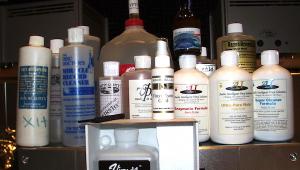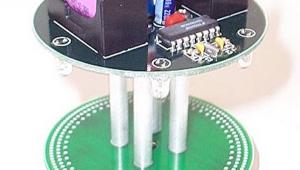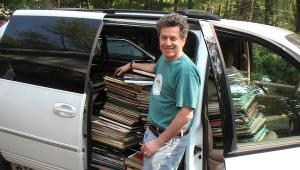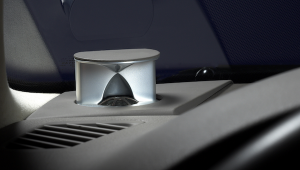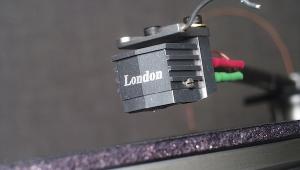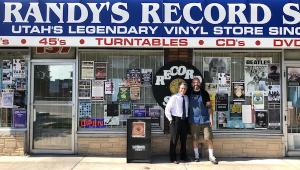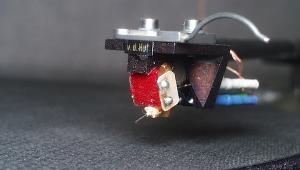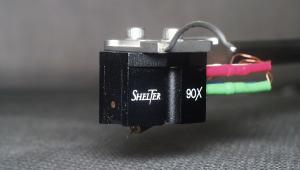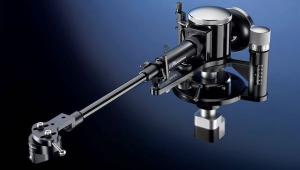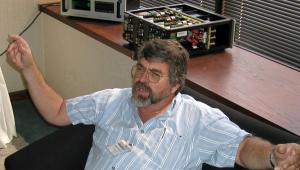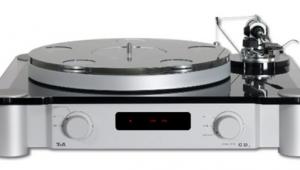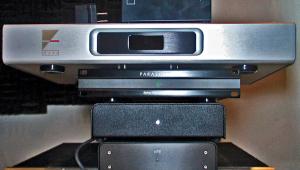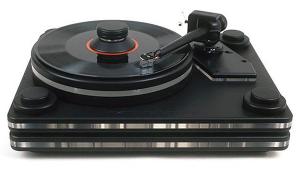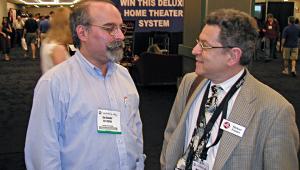Analog Corner #85
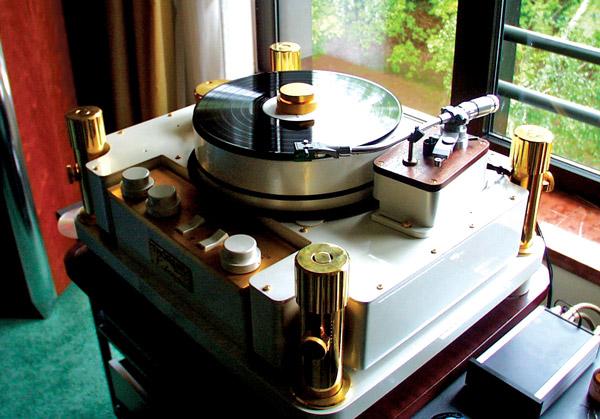
"I was worried about doing it," Speakers Corner's Kai Seemann told me. "If it didn't sell, I'd be out a substantial sum, but I took a chance and pressed 1500 copies, figuring if I did manage to sell them all, it would probably take three years."
Seemann was talking about Ella Fitzgerald's legendary 1950s Gershwin Song Book boxed set, originally released on Verve, which his reissue label had meticulously reproduced on vinyl. "Seven months later, and they're all gone!" he exclaimed wonderingly. He's pressing up another 1000 copies of the set of five LPs (plus bonus 10" LP), which was mastered by Kevin Gray. Those, too, will surely sell out, making the set a collector's item for a second time, a half century after it was first issued.
I was at High End 2002, the annual Frankfurt hi-fi show, which for the past 20 years has been held at the picturesque Kempenski Hotel. Seemann was telling me pretty much what everyone else had been saying all day long: Analog is healthy in Germany and in much of the world. Speakers Corner (www.speakerscorner.de) had its best year in 2001, and vinyl sales this year look to be equally good—some of it coming from beyond the audiophile world. In a new phenomenon in Germany, "lounging," young people sit around clubs listening to "lounging music" like Sergio Mendes and Brazil '66—not on CD, but on vinyl. "A company that reaches these kids bought 500 copies recently," he laughed.
High End 2002 is always stocked with great vinyl, and this year was no exception—new and used record vendors and buyers packed the Kempenski's ballroom. As is usually the case when I visit the event, I found many titles I didn't know were available on wax, like Pete Yorn's Columbia debut, musicforthemorningafter, and the new Neil Young, Are You Passionate?, both on two-LP sets. (The Young vinyl will apparently be available in the US by the time you read this.) The German audio magazine Image Hi-Fi licensed Charlie Haden and Chris Anderson's superb None but the Lonely Heart, on Naim Music, and issued it on a superbly pressed 180gm LP.
I also caught a buzz going around about Nina Nastasia, a young American singer whose Touch and Go LP, The Blackened Air (recorded by Steve Albini), was in a number of rooms and, fortunately, in vinyl seller Da Capo's rack. Sometimes you have to travel halfway around the world to find out about an American artist on an American label.
German audiophiles are among the most enthusiastic vinyl collectors in the world, and the country's homegrown audio industry supports them with both LPs and an almost overwhelming array of hardware. Big turntable manufacturers like Clearaudio and JA Transrotor were on hand, along with familiar names like Amazon and Acoustic Solid. (For reasons I couldn't determine, Brinkmann was MIA.) There were also a few new ones in the mix—at least I'd never heard of them—like DPS, Cassiopeia, Pluto, and STST. While many German turntables are showy assemblages of acrylic and/or chrome, unassuming-looking designs like the DPS and STST were the ones that caught my attention.
Despite language difficulties, I got the scoop on the STST Motus II turntable (ca $3900), which uses a meticulously designed but odd-looking suspension hidden under its plinth. The suspension consists of three distinct mechanisms made from a variety of metals—no two touching or connecting parts are made of the same substance. I gathered that the idea is to effectively dissipate energy and avoid sympathetic resonances while allowing for pistonic suspension movement.
I never met up with the DPS designer in the rooms demonstrating his turntables (€4100 with DC motor, €5500 with AC), but while walking down a hallway looking for someone or other, I spotted Ayre Acoustics' Charley Hansen seated on the floor hunched over a drawing being scribbled by, it turned out, the DPS's designer. Hansen was admiring the drawing of the unique bearing and just telling the guy he should show it to Michael Fremer when I pulled up next to them.
Both DPS turntables I saw were fitted with versions of Frank Schröder's intriguing non-metallic-contact, magnetic-attraction tonearm design, which I've been trying to get for review ever since first seeing it at Hi-Fi News' London show a few years ago. The Schröder arm was all over the show—on a Platine Verdier 'table with a bamboo armtube in one room, on a Transrotor turntable in the Blue Audio room, and on a few Garrard turntables in the Loricraft room. Schröder makes custom versions for both Loricraft and DPS, and sells three basic models directly: the 2 (€1250), the 1 (€2300), and the Reference (€5000). (The arms are being distributed in the US by Audio Advancements.)
The Schröder 1 arm is also available in a 12" version, but it's the Reference that has me drooling. It features a single-thread, virtually frictionless and chatterless torsion bearing with overhang, VTA, VTF, and azimuth repeatably and finely adjustable. Armtubes are custom-made at no additional cost at lengths of from 8.5" to 12", and from carbon fiber, jacaranda, ebony, acacia, bamboo, and other materials.
One of the highlights of the show for me was finally meeting Frank Schröder and sitting down with him for a wide-ranging talk that, had I recorded it, would have taken up this entire column. With his bow tie and wire-rimmed glasses, the crisply dressed, suave-looking 40-year-old looked as if he'd stepped out of an early-'60s spy flick. The watchmaker (among other skills) puts his erudition and considerable charm to work for the German government, escorting visiting political dignitaries to cultural events, among them Bill Clinton, in 1994, whom Schröder accompanied to dinner and, I believe, the opera.
Schröder went into great detail about his design, explaining what he says are its advantages over standard captured bearings and unipivots, and telling me why he prefers wooden armtubes, though he will use other materials when requested. His claims made sense to me, but it's better to discuss them in a review. Schröder's current cartridge of choice is the Lyra Helikon, which he likes in part for its overall speed and crisp attack. He also thinks arm lengths of 9" and 10" are optimal, and that longer buys little tracking advantage while creating other complications. No wonder we got along so well (or was he just being...diplomatic)? I can't wait to get my hands on a Schröder arm, but that could take a while—Schröder sells every one he makes.
Audio Advancements distributes another product that's pre-sold for the foreseeable future: the handmade J. Allaerts cartridges. While talking with Schröder in the Isenberg Audio room, who should walk in but M. Allaerts himself—another mystery man I'd always wanted to meet. Unable to contain myself, I interrupted my conversation with Schröder and got up to speak with the Belgian cartridge builder (whom I once misidentified in this column as being from the Netherlands), leaving Schröder bemused and/or exasperated. When, after resuming my conversation with Schröder, I realized my monumental rudeness, I also realized that Mikey will never make the diplomatic corps.
Allaerts builds five different cartridges (€1350–€9000), all by hand—including the winding of the coils. Only the cantilever/diamond assembly is outsourced. The most expensive model, with an ultra-low output of 0.18mV, was driving an Isenberg Audio phono section designed specifically for it and costing around €9000. We're talking €18,000 just to get the signal to your line stage. Allaerts, too, is back-ordered. Scan-Tech's Jonathan Carr recently said to me, "You should hear one, they're special." Coming from him, that meant something, but given the limited supply, I expect I'll hear an Allaerts cartridge about the time I hear a Schröder arm. However, I've been told that the Allaertses are on the warm, sweet side, which might not be to my liking...though I'm sure I'd respect them in the morning.
Speaking of supply, Simon Yorke, in whose arm and turntable the Allaerts was mounted in that room, told me that he's back-ordered eight months. He can make only about 20 of his handmade 'tables per year. Glad I've got mine. I'm waiting for something to better it (other than the Rockport, of course), but it hasn't happened yet. Yorke also told me he sells three times as many 'tables in Russia as in the US. It's not that difficult to figure: The Soviets missed the CD revolution, so most music buffs kept their vinyl. Now the wealthy ones want to upgrade their turntables.
Incidentally, one audiophile website erroneously reported that Simon Yorke has folded his tents. He is packing up, but not to go out of business. He's moving his family and machine shop to Spain, where he'll continue to build turntables, he assured me.
Among the interesting and unfamiliar turntables I saw at High End 2002 were two from Swiss manufacturer Holborne, shown in the Tubesound Audio room. Both use high-quality Maxxon motors (the company apparently builds motors for the Space Shuttle) driven by pieces of tape. The more expensive one (ca €3000) sported a Corian plinth on which was mounted a neat-looking Ikeda arm (ca €4000). A second arm was in play, via a standalone Kuzma "tower" armbase borrowed from Kuzma's Stabi XL turntable. (The tower, I found out, is available as a separate product, which means you can add a second arm to any 'table with precision VTA adjustability.)
I ran into Franco Kuzma, who told me he's developed a linear-tracking, captured-air–bearing tonearm that is "correctly" designed and will be reasonably priced. Kuzma told me he'd read my articles on air-bearing arms and agreed with what I'd written. The arm may show up at Home Entertainment 2002, which will have taken place by the time you read this.
Loricraft's garrulous and frequently outrageous Terry O'Sullivan proudly introduced the new double-plinthed Garrard 601, which was originally going to be called the Lab 80, bringing back a model name familiar to many of you. O'Sullivan nixed the name after Hi-Fi News's Ken Kessler reminded him that the original Lab 80 had a rumble problem. Hopefully, the new model, driven by an idler wheel and selling for $8000, will be silent. Loricraft is one of the few turntable manufacturers that actually builds its own motors. The Loricraft/Schröder arm adds about $3900, for a breathtaking grand total of around $12,000. I'm hoping to take delivery of a review sample over the summer.
It's always a pleasure to visit with A.J. van den Hul, but this year he had something special to show me: a vintage, limited-edition Thorens Reference turntable, something A.J. said he'd dreamed of owning since 1981, when it was introduced. One of only two made in white became available from a Berlin collector, complete with a Lustre GST 801 arm, and A.J. jumped. But his dream went further than just owning one: he's intent on introducing an updated edition, the Mk.2, the first of which was completed just a few days before the show.
A.J. told me that the marketing company that now owns the Thorens name wants nothing to do with turntables because they're "old-fashioned rubbish," but he convinced them to go forward with the Reference Mk.2, which he's bankrolling. Designer Rolf Keich ran me through the impressive Mk.2, which includes three brass towers the original machinist had in his basement. Knowing that the old 'table was going back into production brought a tear to the old man's eye, Keich told me, which brought one to mine! So did the projected price, which I don't recall, though I think A.J. paid about $16k for the vintage edition.
French Toast
Saturday morning, I drove for two hours with Music Hall's Roy Hall for breakfast in France. One reader thinks such reviewer-manufacturer camaraderie indicates corruption in the audio industry. "You don't see that in politics," he assured me in an e-mail.
Back in the real world, the food was almost worth the four-hour round trip, as was the picturesque setting, though it was saturated with tourists. And, of course, Roy and I had a few laughs on the road talking about everything but audio.
Returning to the Kempenski in late afternoon, I continued, semi-comatose, to make the rounds. I ran into Norbert Lehmann, designer of the Black Cube phono section. He introduced me to his new Silver Cube—something American importer Leo Massi couldn't do at CES because his Cube was MIA. The new Cube (ca $2300) represents a substantial upgrade in build and parts quality from the Black. There's a hefty power supply and a zero-feedback, class-A discrete output stage. I hope to get one for review.
A hallway encounter with Music Direct's Josh Bizar yielded copies of the first two Mobile Fidelity hybrid gold SACDs: Patricia Barber's Caf;ae Blue and Modern Cool. It was a kick seeing MoFi's familiar gold banner and black/gold silk-screening on the discs. Better yet was hearing how even the CD layers creamed the original Premonition/Blue Note CDs. The SACD sound was sublime. I did my listening on a Sony SCD-777ES SACD player modified by Vacuum State Electronics. Vacuum State's Allen Wright (author of The Tube CookBook, a DIY handbook) took me through the mod, which bypasses the Sony's DAC and is available for a number of Sony players. Among other things, it includes a new low-jitter, mil-spec oscillator module, a new op-amp–free analog filter/buffer module, and an 18dB/octave filter at 100kHz that VSE claims will not be a problem for "90%" of solid-state amps. Wright also informed me about his modular preamp, with its many options both solid-state and tubed. It can be had as a kit at great savings (and probably added fun).
As the Saturday show was about to end, I sauntered into the Pro-Ject room. American importer Sumiko has just sent me three of their turntables to review. I haven't opened the boxes yet, but I don't think any will contain the new Studie 'table with 9" and 12" carbon-fiber tonearms. The price of €1500 includes a belt-driven acrylic platter with an inverted-bearing ceramic ball. Luckily, I was familiar with everything else in the room—by this time, I was walking as if I belonged in a George Romero flick!
I caught a ride back to my hotel with a friend. As we walked down the narrow, car-lined road toward the car, we saw some guys loading hi-fi gear into a trunk. Next to them was a cool, slimline, high-tech speaker done up in black and white, which I figured was about to disappear into the trunk as well. "Hey," I said to my friend. "What's that? Who makes it?" "That," he replied, "is a road marker." So it was. There was one between every pair of cars. I needed some sleep.
I hit the hay for a few hours before leaving for the Clearaudio party, which American distributor Garth Leerer had invited me to—one of the big social events at the show. When I awoke to shower and dress, it was 2am. Damn French.
Sunday will Never be the Same
My Sunday job was damage control. I found American Clearaudio importer Garth Leerer and Clearaudio head honcho Peter Suchy and offered my apologies, which seemed to be accepted. Suchy gave me a catalog tour of Clearaudio's extensive line of turntables, arms, and accessories, and a sample of a new and very useful accessory: a picture-disc LP with the "music" being noise and the picture being a strobe pattern. The disc allows you to precisely set speed with stylus drag taken into account—a very good idea. One side of the disc includes the standard 50/60Hz pattern, but the other is designed for a more accurate 300Hz; it requires Clearaudio's special battery-powered blue-light accessory, a sample of which Suchy also gave me to try.
Two items in the Clearaudio catalog were of immediate interest. First was a "spider" for precise centering of the Outer Limit platter ring, which I wrote about last year. It's an absolute necessity for properly using the ring. Second was a record-cleaning machine, which I was told I could see in the Clearaudio room. After another apology and a goodbye, that's where I headed.
Clearaudio's Matrix cleaning machine sells for €1590. It looks very well-built, and was very quiet in a brief demo. It works on the "velvet lip" principle, invented, I believe, by VPI's Harry Weisfeld—as does the new Waschbar machine, from Christian Bierbaumer's Blue Danube Rare Records and HiFi Company, which Jerry Raskin's The Needle Doctor will import and sell direct ($1999). Both machines appear to be worth checking out. Another device I saw at the show, also imported by Needle Doctor, was David's Short Cut alignment protractor. It's similar to the old Dennesen but includes some enhancements, and will sell for around $129. I'll try it and let you know.
Other interesting analog products I saw at the show included: a fully balanced phono section from Blue Audio (€8000; €4400 unbalanced, upgradeable) that sounded quite nice and looked very well-built; the Pluto 12A turntable and arm (€20,000); the Audio Physic Strada digital preamp, including a digital phono section (whether or not it actually digitizes the analog input, I wasn't able to ascertain); and a prototype of the new Scan-Tech Lyra Titan cartridge, which appeared to be a titanium edition of the Helikon with special magnets and some other new features.
In the non-analog arena, Metronome Technologie's Kalista CD transport (€20k) has got to be one of sexiest-looking digital devices out there today. One of the most impressive-sounding and -looking small speakers I heard was Finnish firm Penaudio's Charisma two-way minimonitor. With Charm subwoofer, you get full response. Cost is €5000, but by the time you included import costs and markups, the American price would be around $8000, so it's unlikely anyone will risk bringing in the Charisma. Too bad.
I finally got a chance to listen to Mission's impressive-sounding and -looking Pilastro speaker system, and Audio Physic's new Kronos (€40k), which features active woofers and a new midrange/tweeter coaxial driver, among other innovations. The prototype had been completed the day before the show, the cabinet handbuilt and finished by Hornslet Cabinet's managing director, Jørgen Thomsen, and his son (according to AP's Joachim Gerhard). Thomsen invited me to tour the factory and see how the patented Hornflex technology works, and to tour the Danish Sound Technology (VIFA ScanSpeak) facilities.
I also met with WBT's Wolfgang Thoerner. I complained to him about the WBT terminals on my Audio Physic Avanti IIIs, and how difficult I found it to secure spade lugs on stiff speaker wires because of the terminals' knurled, round design. He promised to built an accessory that would make tightening them easier. Now that's what I call instant gratification!
In Conclusion...
As usual, the Frankfurt High End 2002 show proved to be one of the world's most exciting audio events. It was well-attended, featured a wide variety of interesting products, including many produced specifically for domestic consumption (you wouldn't want to hear some of the bright-sounding "local" speakers I heard), and German interest in vinyl and analog gear remains second to none. As a famous individual from a neighboring country once said, "I'll be back."
